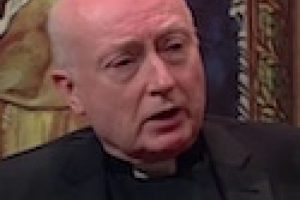Column: From the Pastor
In these days of closures, which must soon end, I am able to offer Mass quietly for the intentions of parishioners and others, and I often take the opportunity to use the Extraordinary Form, whose beautiful cadences end with the “Last Gospel.” This Johannine Prologue in hymnodic verse concluded the Liturgy from the earliest days of the Faith, as a reminder that “the Word was made flesh” and, by being received into the flesh of communicants, makes them living tabernacles commissioned to take Christ into the world. He is the Light that shines in the darkness, and “the darkness has not overcome it” (John 1:5).
The present pandemic has spread a cultural darkness that contrasts with the growing brightness of late spring days. Any amateur artist, if untutored, must learn by experiment that the brightest colors in his paint box are brilliant on canvass not by themselves but by contrast with dark tones. There is remnant evidence that this application in art goes back about 2,500 years to the Athenian muralist Apollodorus. It may seem obvious, but it was not so until it was tried, and in fact it was gradually forgotten until rediscovered in the Renaissance. The contrast of light and dark, chiaroscuro, was mastered by the likes of Leonardo, Caravaggio and then Rembrandt and Vermeer. It conveys brooding as well as rejoicing, and “film noir” of modern cinematography made as much use of darkness as earlier art made of light.
It remains to be seen if what we call normalcy will be restored. It is certain that “things will never be the same” because things present by definition can never be what they used to be. Whether this be good or bad depends on what is learned from having passed from darkness into light (cf. Isaiah 9:2). This is the Gospel essence that the first Christians gave to a world that had accustomed itself to a life of shadows. “For at one time you were darkness, but now you are light in the Lord. Walk as children of light” (Ephesians 5:8).
During these long weeks, the absence of votive lights in a darkened church has contrasted with the candles that used to burn here, and I hope that soon there will be even more lit than before. But all this time, a lamp has burned before the Blessed Sacrament.
One recalls that passage from Waugh’s novel Brideshead Revisited describing the sanctuary lamp in a desolate chapel during the darkness of a World War: “. . . the flame which the old knights saw from their tombs, which they saw put out; that flame burns again for other soldiers, far from home, farther, in heart, than Acre or Jerusalem. It could not have been lit but for the builders and the tragedians, and there I found it this morning, burning anew among the old stones.”
RELATED RESOURCES:
- NEW BOOK: “The Wit and Wisdom of Fr. George Rutler” – by Fr. George W. Rutler
————-
Fr. George W. Rutler, S.T.D., is a brilliant scholar, author, convert, former pastor of Our Saviour in Midtown Manhattan, the closest Catholic parish near the site of 9-11, and now pastor of St Michael’s parish in Hell’s Kitchen, New York City. A donation of any amount may be made to the parish at: www.StMichaelNYC.com.
View Articles Father Rutler was ordained to the diaconate in Rome by His Eminence William Cardinal Baum in 1980 and received priestly ordination in St. Patrick's... MORE »



You must be logged in to post a comment.